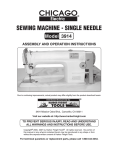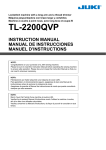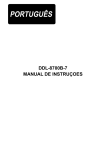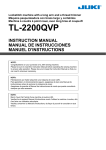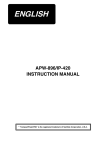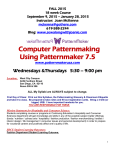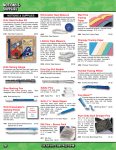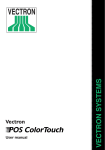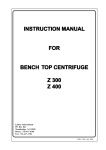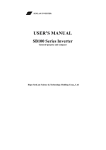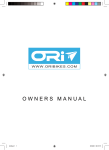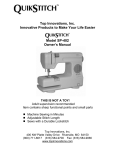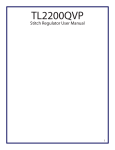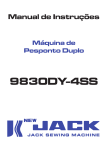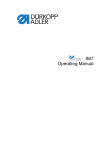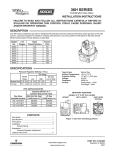Download Instruction Manual
Transcript
Lockstitch machine with a long arm and a thread trimmer TL-2200QVP INSTRUCTION MANUAL NOTE: Congratulations on your purchase of a JUKI sewing machine. Please be sure to read this Instruction Manual before operating the sewing machine to ensure safe operation. Please be sure to keep the Instruction Manual so that you can read it whenever necessary. EN ES FR IT NL DE CS PL RU JA “IMPORTANT SAFETY INSTRUCTIONS” When using an electrical appliance, basic safety precautions should always be followed, including the following: Read all instructions before using this sewing machine. “DANGER ____ To reduce the risk of electric shock:” 1. The appliance should never be left unattended when plugged in. 2. Always unplug this appliance from the electric outlet immediately after using and before cleaning. “WARNING ____ To reduce the risk of burns, fire, electric shock, or injury to persons:” 1. Do not allow this appliance to be used as a toy. Close attention is necessary when this appliance is used by or near children. This appliance can be used by children aged from 8 years and above and persons with reduced physical, sensory or mental capabilities or lack of experience and knowledge if they have been given supervision or instruction concerning use of the appliance in a safe way and understand the hazards involved. Children shall not play with the appliance. Cleaning and user maintenance shall not be made by children without supervision. 2. Use this appliance only for its intended use as described in this manual. Use only attachments recommended by the manufacturer as contained in this manual. 3. Never operate this appliance if it has a damaged cord or plug, if it is not working properly, if it has been dropped or damaged, or dropped into water. Return the appliance to the nearest authorized dealer or service center for examination, repair, electrical or mechanical adjustment. 4. Never operate the appliance with any air openings blocked. Keep ventilation openings of the sewing machine and foot control free from the accumulation of lint, dust, and loose cloth. 5. Keep fingers away from all moving parts. Special care is required around the sewing machine needle. 6. Always use the proper stitch plate. The wrong plate can cause the needle to break. 7. Do not use bent needles. 8. Do not pull or push fabric while stitching. It may deflect the needle causing it to break. 9. Switch the sewing machine off “O” when making any adjustments in the needle area, such as threading needle, changing needle, threading bobbin, or changing presser foot. 10. Always unplug the machine from the electrical outlet when removing covers, when lubricating or when making any other user servicing adjustments mentioned in the instruction manual. 11. Never drop or insert any object into any opening. 12. Do not use outdoors. 13. Do not operate where aerosol (spray) products are being used or where oxygen is being administered. 14. To disconnect, turn all controls to the off “O” position, then remove plug from outlet. 15. Do not unplug by pulling on cord. To unplug, grasp the plug, not the cord. 16. Turn OFF the power switch before insertion/removal of any cord and any plugs. “SAVE THESE INSTRUCTIONS” “This sewing machine is intended for household use.” –1– Congratulations on your purchase of a JUKI sewing machine. Please be sure to read safety precautions in “To use the sewing machine safely” in the Instruction Manual before use to fully understand the functions and operating procedures of the sewing machine so as to use the sewing machine for a long time. After you have read the Instruction Manual, please be sure to keep it together with the warranty so that you can read it whenever necessary. To use the sewing machine safely Marks and pictographs included in the Instruction Manual and shown on the sewing machine are used so as to ensure safe operation of the sewing machine and to prevent possible risk of injury to the user and other people. Warning marks are used for different purposes as described below. WARNING Indicates that there is a possible risk of death or serious injury if this mark is ignored and the sewing machine is used in a wrong manner. CAUTION Indicates the operation, etc. which can cause a possible risk of personal injury and/or physical damage if this mark is ignored and the sewing machine is used in a wrong manner. Pictographs mean the following: Danger warning which is not specified There is a risk of electrical shock There is a risk of fire There is a risk of injury to hands, etc. Prohibited matter which is not specified Disassembly/ alteration is prohibited Do not place fingers under the needle Do not pour oil, etc. Generally required behavior Disconnect the power plug –2– WARNING For the combination of the material and the thread and needle, in particular, refer to the explanation table in “Replacement of the needle”. If the needle or thread does not match the material used such as in the case that an extra heavy-weight material (e.g., denim) is sewn with a thin needle (#11 or higher), the needle can break resulting in an unexpected personal injury. Other precautions ● Do not put the sewing machine under the direct sunlight or in a humid place. ● Do not wipe the sewing machine with solvent such as thinner. When the sewing machine is soiled, put a small quantity of neutral detergent on a piece of soft cloth and carefully wipe off the sewing machine with it. Be aware that the following state can take place since the sewing machine incorporates semi-conductor electronic parts and precise electronic circuits. ● This sewing machine will stop due to safety mechanism to prevent the machine from overheating, when it sews slowly and for a long time. At this time, turn off the power switch, after a while please be ON the power switch. Stop! ● Be sure to use the sewing machine in the temperature range from 5ºC to 40ºC. If the temperature is excessively low, the machine can fail to operate normally. * The operating temperature of the sewing machine is between 5ºC and 40ºC. Do not use the sewing machine under the direct sunlight, near the burning things such as a stove and candle, or in a humid place. By so doing, the temperature in the interior portion of the sewing machine can rise or the coating of the power cord can melt, causing fire or electrical shock. –3– How to carry the sewing machine ■ A How to take out the sewing machine CAUTION If you pull up the sewing machine by holding presser regulating screw section A , the sewing machine can break. In addition, be aware that the presser regulating screw can break if a physical impact is given to it. Pull out the sewing machine from the cutout of styrene foam by holding the main body of the arm. CAUTION Turn OFF the power switch. Always must be disconnected plug from socketoutlet. ■ How to hold the sewing machine CAUTION 1. Never hold the handwheel since it rotates. 2. Always must be handle the sewing machine with two persons or more since the sewing machine weighs 26 kg or more. 3. Do not hold the sewing machine by placing hands near the needle bar and the presser bar to avoid the risk of injury. Carry the sewing machine while holding the machine arm with two persons as shown in the figure. –4– GROUNDING INSTRUCTIONS This product must be grounded. In the event of malfunction or breakdown, grounding provides a path of least resistance for electric current to reduce the risk of electric shock. This product is equipped with a cord having an equipment-grounding conductor and a grounding plug. The plug must be plugged into an appropriate outlet that is properly installed and grounded in accordance with all local codes and ordinances. DANGER - Improper connection of the equipment-grounding conductor can result in a risk of electric shock. The conductor with insulation having an outer surface that is green with or without yellow stripes is the equipment-grounding conductor. If repair or replacement of the cord or plug is necessary, do not connect the equipment-grounding conductor to a live terminal. Check with a qualified electrician or serviceman if the grounding instructions are not completely understood, or if in doubt as to whether the product is properly grounded. Do not modify the plug provided with the product. if it will not fit the outlet, have a proper outlet installed by a qualified electrician. Figure 1 Grounding pin (A) Grounding pin (C) Grounding pin –5– (B) (D) CONTENTS Safety regulations.......................................................................................1-3 How to carry the sewing machine................................................................. 4 GROUNDING INSTRUCTIONS.................................................................... 5 Specifications................................................................................................ 7 Accessories................................................................................................... 8 Setup and operation ................................................................................9-11 Principal Parts ............................................................................................ 12 Name and Function of each component................................................13-17 Winding the bobbin ................................................................................18-21 Threading the machine (needle thread) ..................................................... 22 Adjusting the thread tension ....................................................................... 23 Tabulated relationship between material, thread and needle ..................... 24 Presser foot lifting lever .............................................................................. 24 Attaching the needle .................................................................................. 25 Maintenance ............................................................................................... 25 Maintenance and lubrication....................................................................... 26 Troubles and Corrective measures ............................................................ 27 –6– Specifications Description Specification Sewing speed Max. 2,200 sti/min Needle bar stroke 35mm Lift of presser foot 5.5mm Needle GB 134R Lubricating oil New Defrix Oil No.1 Dimensions of sewing machine 22.2W x 46.0H x 73.0L (cm) Weight of sewing machine 26 kg Rated power supply / Power consumption AC100V-AC240V/1.2A-0.8A, 50/60Hz –7– Accessories 1 2 3 4 5 6 7 8 1. Power cord 2. Exclusive screwdriver 3. Screwdriver (small) 4. Cleaning brush 5. Bobbins (4pcs.) 6. Oiler 7. Needles (GB 134R #18) 8. Spool cap 9. Thread stand components (spool holder, thread stand thread guide, bobbin winder spool pin, bobbin winder seat, anti-vibration cone (2 pcs.), setscrew large, setscrews small (2 pcs.)) 10. Eye protection cover components (safety plate, safety plate mounting plate, washers (2 pcs.), setscrews large (2 pcs.), setscrews small (2 pcs.)) 11. Thread guide pin 12. Masking seal 9 10 11 12 –8– Setup and operation ■ Basic Operating Procedures 1) Insert the electric power cord plug into the corresponding inlet. Turn ON the power switch. This is described in the Instruction Manual. 2) Set the machine settings from the LCD screen. You can set the maximum sewing speed and the automatic thread trimming at the end of sewing. For details, please refer to the "Stitch Regulator User Manual". Screen of stand-up type Screen of sit-down type 85% 15% 60% 85% <1. Stand-up type> 1 Setting the Maximum Sewing Speed You can set the maximum sewing speed in 5% increments. 2 Setting the Stitch Mode • Cruise Stitch Mode When you press the "start button" on the right handlebar, the machine will sew at the maximum sewing speed that has been set. When you move the sewing machine by the handles, the machine will sew automatically with a sewing speed so that the set "Stitch per Inch" (SPI) can be maintained. • Baste Stitch Mode When you press the "start button" on the right handlebar and move the sewing machine by the handles, it will sew with the stitch length that has been set. –9– • Precise Stitch Mode The sewing machine won’t sew, even if you press the "start button" on the right handlebar. When you move the sewing machine by the handles, the machine will automatically sew a constant stitch length according to the distance moved. • Manual Stitch Mode When you press the "start button" on the right handlebar, the machine will sew at the maximum sewing speed that has been set. 3 Trimming Thread When you press this button, threads are trimmed automatically. * Start sewing. In a "stand-up" setup, you can stitch by moving the machine. Head of the machine Left Button needle up/down LCD Screen Right Button Starts/Stops When you press the "start button" on the right handlebar, the sewing machine will start sewing according to your settings. When you press the "start button" again, the sewing machine will stop sewing. Caution LED Lights LED Lights • Don't put any heavy objects on the quilting frame and don't put a load heavier than normal sewing. • Be careful of surrounding people and objects since you move the machine and sew. • Left Handlebar Right Handlebar If you move the assembled quilting frame, some parts may be damaged or bent. When moving the quilting frame, disassemble it, and then reassemble it correctly after it has been delivered. * Use the screwdriver included with the sewing machine to remove any hazardous sharp shavings from the disassembled quilting frame and other components, as there is a risk of injury from such hazardous sharp points. – 10 – <2. Sit-down type> 1 Setting the Maximum Sewing Speed You can set the maximum sewing speed in 5% increments. 85% 15% 60% 85% 2 Auto Thread Trimming Function The sewing machine will trim the threads automatically when it stops. 85% 15% 60% 85% A B 3 Sewing and Manual Thread Trimming When you press part A of the foot controller (pedal), the sewing machine will start sewing. The sewing machine sews at a faster speed according to the amount that part A is pressed. When you release your foot from part A, the machine will stop. When you press part B, the machine will trim the threads. * Start sewing. While pressing the foot controller (pedal), move the fabric to form stitches. Caution * – 11 – While sewing, don't pull or push the fabric with force, as it will cause the needle to break or cause injuries. Principal Parts 7 1 8 2 15 3 9 10 11 17 6 4 12 13 5 16 20 23 24 22 1. 2. 3. 4. 5. 6. 7. 8. 9. 10. 11. 12. 13. 14. 15. 16. 17. 18. 19. 20. 21. 22. 23. 24. Thread trimmer retaining plate Bobbin winder guide Presser foot pressure regulator Thread tension dial Lamp (built-in type) Hand pulley Support rod Spool pin Anti vibration cone Bobbin presser Bobbin thread winding shaft Power switch Inlet of electric power cord Presser foot lifting lever Thread guide pin Eye protection cover Tension controller No. 1 Hand wheel Presser regulator cover Stitch regulator connection connector Panel junction cable connection connector Hook cover Connecting plate (large) Connecting plate (small) 19 21 18 14 7 4 1 2 5 6 1. Screw in the presser foot 2. Presser foot 3. Throat plate 4. Needle clamp 5. Needle bar thread hook 6. Needle 7. Needle bar thread guide 3 – 12 – Name and Function of each component ■ Power cord Insert the electric power cord plug into the corresponding inlet. CAUTION Turn OFF the power switch before insertion/removal of any cords and any plugs. Perform these following steps before you are not using your sewing machine. 1. Turn OFF the power switch. 2. Remove the power plug from the wall outlet. ■ ON Power switch Turn ON the machine, set the power switch to “I”. Turn OFF the machine, set the power switch to “O”. OFF – 13 – ■ 2 Installing the thread stand CAUTION Turn OFF the power switch. Always must be disconnected plug from socket-outlet. 1 6 1. Insert bobbin winder spool pin 2 into spool holder 1. Fix the former with setscrew 3. 2. Set bobbin winder seat 4 and two anti-vibration cones 5 on spool holder 1. 3. Set thread stand thread guide 6 on the top of bobbin winder spool pin 2. 4. Install thread stand 7 on frame 9 with two setscrews 8. 3 5 4 7 9 8 1 ■ Installing the thread guide CAUTION Turn OFF the power switch. Always must be disconnected plug from socket-outlet. 2 Insert thread guide pin 1 into the frame with the holes in the pin faced to tension controller No. 1 2. Pat the top of the thread guide pin with the handle of screwdriver to prevent the pin from slipping off easily. – 14 – ■ Panel cord binding procedure CAUTION Turn OFF the power switch. Always must be disconnected plug from socket-outlet. 1 1 Remove two setscrews from the presser regulator cover. Remove the presser regulator cover. 2 Place the panel cord as illustrated in the figure. It is necessary to place the panel cord at a position where the cord does not come in contact with the mechanical parts. 3 Align the notch in the cover with the panel cord. 4 Fix the presser regulator cover with the setscrews. 2 3 4 1 3 4 2 – 15 – ■ 6 Installing the eye protection cover CAUTION Turn OFF the power switch. Always must be disconnected plug from socket-outlet. 2 5 3 4 DANGER Be sure to install the eye protection cover since the cover protects eyes from being injured by a fragment of a broken needle. 1 1. Place eye protection cover 2 and washer 3 in the written order on eye protection cover mounting plate 1 and fix them with setscrew 4. 2. Install eye protection cover mounting plate 1 on frame 6 with two setscrews 5. ■ Decrease Increase Presser foot pressure regulator and its indicator CAUTION Turn OFF the power switch. Turning the presser foot pressure regulator adjusts the pressure of the presser foot. ■ 1 2 3 Adjusting the presser foot height CAUTION Turn OFF the power switch. Always must be disconnected plug from socket-outlet. If the sewing machine does not smoothly run because of the material thickness, it is necessary to change the presser foot height. Bring needle bar 1 to the lowest point end. Loosen setscrew 2 and adjust the height of presser foot 3. The minimum clearance between the throat plate and the presser foot has been factoryadjusted to 0.5 mm at the time of shipment. CAUTION Minimum clearance between the throat plate and the presser foot: 0.5 mm (at the time of shipment) If the upper position of the presser foot is too high, stitches cannot be formed. – 16 – ■ 1 2 Stoke is increased Upper position: Stroke is 1 to 3 mm Stroke is decreased 3 Lower position: Stroke is 3 to 5 mm 1 ■ 1 Adjusting the presser foot stroke It is possible to adjust the presser foot stroke. Remove presser regulator cover. Loosen nut 1. Shift block 2 upward to increase the stroke, or downward to decrease it. To increase the stroke more, change the position of setscrew 3 of the link arm to the lower position (stroke: 3 to 5 mm). The setscrew has been factory-set at the upper position (stroke: 1 to 3 mm) at the time of shipment. After the completion of the adjustment, install the presser regulator cover which you have removed before the adjustment. CAUTION When the stroke is changed, the clearance between the presser foot and the throat plate will change. Re-adjust the presser foot height to a value which matches the material thickness. Handwheel CAUTION Keep hand away from the handwheel while the sewing machine is running. 1 Push and turn the hand pulley to turn the main shaft. 2 Turn on the power switch. White marker dot (A) on the handwheel 2 A B is brought to the right front as observed from just beside. White marker dot (A) is in the front side: The thread take-up lever comes up to its upper end. Green marker dot (B) is in the front side: Not used Red marker dot (C) is in the front side: It is used as the marker dot at the time of lubricating. C – 17 – Winding the bobbin 3 5 4 1 Positioning latches 2 Bobbin winder guide Bobbin presser Bobbin thread winding shaft Thread trimmer retaining plate 1 Installing the thread guide. CAUTION 1 2 3 4 5 Turn OFF the power switch. Raise the support rod fully, turning slightly until the positioning latches engage. Set the large spool over the anti vibration cone. Set the household-type thread onto the spool pin and then insert a spool cap in place. To set a large-diameter spool, set the anti vibration cone upside down to stabilize the spool. Pass the thread coming from the spool on the thread guide pin (rod) just above the spool. – 18 – 2 CAUTION Turn OFF the power switch. ■ Take out the bobbin case. 3 ■ Take out the bobbin from the bobbin case. 4 ■ Thread the bobbin winder guide. 5 ■ Installing the bobbin. 1 Bring up the needle. Open the hook cover. Take out the bobbin case. Snap in the latch to let the bobbin come out of the bobbin case. 1 Wind thread on the bobbin clockwise by several turns. 2 Place the bobbin on the bobbin thread winding shaft. 3 Press the bobbin presser. Thread is automatically wound on the bobbin. 2 3 – 19 – 6 ■ Upon completion of winding the bobbin. 7 ■ Loading the bobbin into the bobbin case. Return the bobbin presser to its home position. Take out the bobbin. Trim the thread with the thread cutting knife. Snap in the bobbin case latch, and put the bobbin into the bobbin case so that the bobbin runs clockwise. Passing the thread through the slit of the bobbin case, continue passing it under the thread tension spring, and pull out the thread open end about 10cm from the bobbin case. Thread passage Thread tension spring 10cm * The bobbin should run clockwise. 8 CAUTION Turn OFF the power switch. ■ Set the bobbin in the sewing machine. Insert the bobbin case fully into the hook, and close the bobbin case latch. Close the hook cover. – 20 – Adjusting the bobbin winder guide Good Thread unevenly wound around the bobbin would badly affect the bobbin thread tension. Thicker toward downside Loosen the screw of the bobbin winder guide to make adjustment. Move up Loosens Thicker toward upside Move down Tightens – 21 – Threading the machine CAUTION Turn OFF the power switch before threading or passing thread. 1 2 7 * Bring the thread take-up 7 to the upper end of its stroke. Then, pass the thread through it. Thread take-up 6 8 5 3 4 9 0 1 11 a ■ Pass the thread through the thread guide 1. 3 1 ■ 9 Pass the thread through the thread guides 9 and 0. Thread the needle a. 0 a 2 ■ 7 8 2 Thread the machine head in numerical order, 2 to 8. 6 5 4 3 Thread tension disk Pass the thread through the clearance between the two thread tension disks. – 22 – Adjusting the thread tension Turn OFF the power switch before taking out the bobbin case or replacing the needle. CAUTION · Adjusting the bobbin case Tension adjusting screw Increase As a measure of the thread tension applied by the bobbin case, when a bobbin (Cotton TEX40) is loaded in the bobbin case, the bobbin should slowly drop by its own weight as illustrated in the figure. * Adjust the needle thread tension in accordance with the bobbin thread tension. * The bobbin case for the TL-2200QVP is an exclusive JUKI part. Please consult the JUKI dealers when you purchase it. Decrease · Proper thread tension Improperly adjusted thread tension may cause puckering on materials, inferior stitches, or thread breakage. The needle thread tension is too low Needle thread Thread tension dial Needle thread Bobbin thread Center of the material Increase the needle thread tension. The needle thread tension is too high Needle thread Bobbin thread Bobbin thread – 23 – Decrease the needle thread tension. ■ 1 Tension controller No. 1 When tension nut No. 1 1 is turned to the right A, the remaining length of thread after thread trimming is shortened. When it is turned to the left B, the remaining length of thread is lengthened. * Be sure to carry out back tacking by several stitches at the beginning of sewing. B A Tabulated relationship between material, thread and needle Material Thread Needle Cotton broadcloth *2 + felt A&E Signature Machine Quilting Thread (cotton) TEX40 #18 Cotton broadcloth *2 + felt YLI Machine Quilting Thread (cotton) TEX40 #18 * Be sure to check the relationship between the material and the needle or thread by carrying out trial stitching on a waste piece of the cloth to be sewn. * Decrease the sewing speed when using frictional thread such as the metallic thread. * Thread may not be trimmed with ease depending on its type. In this case, In this case, be sure to shift the sewing machine toward the handwheel before trimming the thread. Presser foot lifting lever ■ 2 1 Presser foot lifting lever The presser foot can be brought to its upper position or to its lower position by lifting/lowering the presser foot lifting lever. 1 Lowered position …… The position of the presser foot during sewing. 2 Upper position …… The position of the presser foot during placement/removal of a sewing product on/ from the sewing machine. * Before starting sewing, be sure to lower the presser foot lifting lever. If you carry out sewing with the presser foot lifting lever lifted, needle breakage, sewing machine failure and stitching failure can occur. 2 1 – 24 – Attaching the needle Needle clamp screw CAUTION Turn OFF the power switch. Tightens Attaching the needle 1. Turn OFF the power switch. 2. Lower the presser foot. 3. Move the needle bar up to the highest position of its stroke. 4. Holding a needle with its long groove faced to the left, insert the needle into the needle bar until it will go no further. Then, tighten the needle clamp screw. Needle with a round shank Loosens Scarf Face the long groove on the needle to the left Checking the needle ● Check the needle for its straightness occasionally. Any defective needle would cause needle breakage, stitch skipping, thread breakage or damage to materials. Parallel Flat plate Maintenance ■ Replacing the masking seal CAUTION Turn OFF the power switch. Always must be disconnected plug from socket-outlet. 1 3 1. Remove two setscrews 2 and 3 from LED cover 1. Then, the LED cover can be lowered. 2. Rip off the stained masking seal. Put new masking seal 4 in place. 4 2 – 25 – Maintenance and lubrication Always must be disconnected plug from socket-outlet before cleaning or lubricating the sewing machine. CAUTION Cleaning the hook ● Turn OFF the power switch. Remove the needle. ● Loosen the screws to remove the throat plate. ● Then clean up the hook components using a cleaning brush. Lubricating the machine 1 Bring the red marker dot to the right front. CAUTION 1. If oil gets in eyes, immediately rinse the oil out with water. If you swallow oil by mistake, immediately consult a medical doctor. 2. Keep this machine away from children. 3. Waste oil disposal is legally obliged. Dispose of the waste oil according to the relevant legislation. 2 The sewing machine can be lubricated in two different methods. Select one of the two methods for lubrication. 1 1. Lubricate the machine after removing the bobbin case. 2. Turn the handwheel so that its red marker dot comes to the right front as viewed from just beside the sewing machine. 3. Apply one or two drops of oil to the hole indicated by the arrow. 2 1. Lubricate the machine after removing the bobbin case. 2. Apply one or two drops of oil to the arrowed sections shown in the figure. ● ● ● ● Use the machine oil (New Defrix Oil No.1 or similar) supplied with the machine. After the lubrication, turn the handwheel by hand to allow the oil to spread in the whole hook. For daily use, lubricate the sewing machine once a day. After unpacking or after the sewing machine remained unused for an extended period of time, apply a larger quantity of oil (five to seven drops) than usual. If the quantity of oil is excessive, oil can drop on the material. Take care not to apply an excessive quantity of oil to the needle bar and the hook section. ● After the lubrication, carry out trial stitching without exceptions. – 26 – Troubles and Corrective Measures If sewing difficulties occur, make sure the instructions are correctly followed. If a problem still exists, the reminders below help to solve it. Troubles Case Corrective measures Page Stitches are skipped. 1. The needle is bent or the needle point is blunted. 2. The needle has not been attached to the needle bar properly. · Replace the needle. 26 · Attach the needle properly to the needle bar. 26 · Correct the threading. 23 Needle thread breaks. 1. The machine head has been threaded incorrectly. 2. The needle thread tension is too high or low. 3. The needle is bent or the needle point is blunted. 4. The needle is not suited to the thread used. · Properly adjust the thread tension. 24 · Replace the needle. 26 · Replace the needle by the one suited to the thread used. 26 The bobbin thread breaks. 1. The bobbin thread tension is too high. 2. The rubbing of the bobbin case spring has produced a slot. 3. Scratches on the needle hole in the throat plate. · Decrease the tension. · Replace the bobbin case. 24 - · Replace the throat plate. - The needle breaks. 1. The needle is bent or has been installed improperly. 2. The needle hits the throat plate or the presser foot. · Replace or correctly attach the needle. 1. The tension of the needle thread is not balanced with that of the bobbin thread. 2. When the combination of the needle and the thread is improper. 3. The needle is too thick for the material. · Balance the tension. 24 · Properly correct the combination of needle and the thread. · Replace the needle by the one suited to the material. 25 Stitch performance is bad. 1. The tension of the needle thread is not balanced with that of the bobbin thread. · Balance the tensions. 24 The rotation noise is too heavy or too high. 1. Thread wastes accumulate in the hook. · Clean up the sewing machine. 27 The handwheel does not rotate smoothly or does not turn. 1. The thread is entangled and caught in the hook. · Lubricate the hook, strongly turn the handwheel clockwise and counterclockwise several times, then remove the thread caught in the hook. - 1. Remaining length of thread is shorter. · Loosen the tension controller No. 1 (turn to the left) to increase the remaining length of thread after automatic thread trimming. · Draw thread through the needle eyelet to adjust the remaining length of thread to approximately 5 cm. · Be sure to carry out back tacking by several stitches at the beginning of sewing. 25 Stitches are puckered. The sewing machine cannot perform sewing at the beginning of sewing. 2. Back tacking has not been carried out. – 27 – · Correctly position the needle, throat plate, or presser foot. 26 - 25 25





























